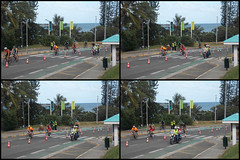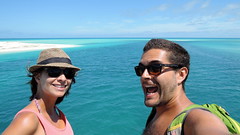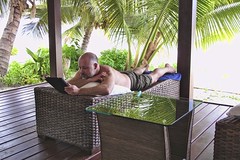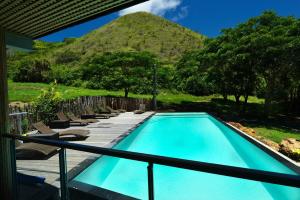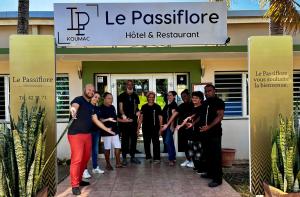 New Caledonia
New Caledonia
New Caledonia (English: /ˌkælᵻˈdniə/; French: Nouvelle-Calédonie) is a ''sui generis'' collectivity of overseas France in the southwest Pacific Ocean, south of Vanuatu, about east of Australia, and from Metropolitan France. The archipelago, part of the Melanesia subregion, includes the main island of Grande Terre, the Loyalty Islands, the Chesterfield Islands, the Belep archipelago, the Isle of Pines, and a few remote islets. The Chesterfield Islands are in the Coral Sea. French people, especially locals, call Grande Terre "" ("the pebble").
New Caledonia has a land area of divided into three provinces. The North and South Provinces are on the New Caledonian mainland, while the Loyalty Islands Province is a series of three islands off the east coast of mainland. New Caledonia's population of 271,407 (October 2019 census) is of diverse origins and varies by geography; in the North and Loyalty Islands Provinces, the indigenous Kanak people predominate, while the wealthy South Province contains significant populations of European (Caldoches and Metropolitan French), Kanak, and Polynesian (mostly Wallisian) origin, as well as smaller groups of Southeast Asian, Pied-Noir, and North African heritage. The capital of New Caledonia is Nouméa.
History
New Caledonia was part of the continent Zealandia, which broke off from the supercontinent Gondwana between 79 million and 83 million years ago. The earliest traces of human presence in New Caledonia date back to the period when the Lapita culture was influential in large parts of the Pacific, c. 1600–500 BCE or 1300–200 BCE The Lapita were highly skilled navigators and agriculturists. The first settlements were concentrated around the coast and date back to the period between c. 1100 BCE to 200 CE.
British explorer James Cook was the first European to sight New Caledonia, on 4 September 1774, during his second voyage. He named it "New Caledonia", as the northeast of the island reminded him of Scotland. The west coast of Grande Terre was approached by the Comte de Lapérouse in 1788, shortly before his disappearance, and the Loyalty Islands were first visited between 1793 and 1796 when Mare, Lifou, Tiga, and Ouvea were mapped by English whaler William Raven. Raven encountered the island, then named Britania, and today known as Maré (Loyalty Is), in November 1793. From 1796 until 1840, only a few sporadic contacts with the archipelago were recorded. About 50 American whalers left record of being in the region (Grande Terre, Loyalty Is., Walpole and Hunter) between 1793 and 1887. Contacts with visiting ships became more frequent after 1840, because of their interest in sandalwood.
As trade in sandalwood declined, it was replaced by a new business enterprise, "blackbirding", a euphemism for taking Melanesian or Western Pacific Islanders from New Caledonia, the Loyalty Islands, New Hebrides, New Guinea, and the Solomon Islands into slavery, indentured or forced labour in the sugarcane plantations in Fiji and Queensland by various methods of trickery and deception. Blackbirding was practised by both French and Australian traders, but in New Caledonia's case, the trade in the early decades of the twentieth century involved kidnapping children from the Loyalty Islands to the Grand Terre for forced labour in plantation agriculture. New Caledonia's primary experience with blackbirding revolved around a trade from the New Hebrides (now Vanuatu) to the Grand Terre for labour in plantation agriculture, mines, as well as guards over convicts and in some public works. In the early years of the trade, coercion was used to lure Melanesian islanders onto ships. In later years indenture systems were developed; however, when it came to the French slave trade, which took place between its Melanesian colonies of the New Hebrides and New Caledonia, very few regulations were implemented. This represented a departure from contemporary developments in Australia, since increased regulations were developed to mitigate the abuses of blackbirding and 'recruitment' strategies on the coastlines.
The first missionaries from the London Missionary Society and the Marist Brothers arrived in the 1840s. In 1849, the crew of the American ship Cutter was killed and eaten by the Pouma clan. Cannibalism was widespread throughout New Caledonia.
French colonisation
On 24 September 1853, under orders from Emperor Napoleon III, Admiral Febvrier Despointes took formal possession of New Caledonia. Captain Louis-Marie-François Tardy de Montravel founded Port-de-France (Nouméa) on 25 June 1854. A few dozen free settlers settled on the west coast in the following years. New Caledonia became a penal colony in 1864, and from the 1860s until the end of the transportations in 1897, France sent about 22,000 criminals and political prisoners to New Caledonia. The for 1888 indicates that 10,428 convicts, including 2,329 freed ones, were on the island as of 1 May 1888, by far the largest number of convicts detained in French overseas penitentiaries. The convicts included many Communards, arrested after the failed Paris Commune of 1871, including Henri de Rochefort and Louise Michel. Between 1873 and 1876, 4,200 political prisoners were "relegated" to New Caledonia. Only 40 of them settled in the colony; the rest returned to France after being granted amnesty in 1879 and 1880.
In 1864, nickel was discovered on the banks of the Diahot River; with the establishment of the Société Le Nickel in 1876, mining began in earnest. To work the mines the French imported labourers from neighbouring islands and from the New Hebrides, and later from Japan, the Dutch East Indies, and French Indochina. The French government also attempted to encourage European immigration, without much success.
The indigenous Kanak people were excluded from the French economy and from mining work, and ultimately confined to reservations. This sparked a violent reaction in 1878, when High Chief Ataï of La Foa managed to unite many of the central tribes and launched a guerrilla war that killed 200 Frenchmen and 1,000 Kanaks. A occurred in 1917, with Protestant missionaries like Maurice Leenhardt functioning as witnesses to the events of this war. Leenhardt would pen a number of ethnographic works on the Kanak of New Caledonia. Noël of Tiamou led the 1917 rebellion, which resulted in a number of orphaned children, one of whom was taken into the care of Protestant missionary Alphonse Rouel. This child, Wenceslas Thi, would become the father of Jean-Marie Tjibaou (1936–1989).
Europeans brought new diseases such as smallpox and measles, which caused the deaths of many natives. The Kanak population declined from around 60,000 in 1878 to 27,100 in 1921, and their numbers did not increase again until the 1930s.
In June 1940, after the fall of France, the ''Conseil Général'' of New Caledonia voted unanimously to support the Free French government, and in September the pro-Vichy governor was forced to leave for Indochina.
In 1941, some 300 men from the territory volunteered for service overseas. They were joined, in April, by 300 men from French Polynesia ('the Tahitians'), plus a handful from the French districts of the New Hebrides: together they formed the Bataillon du Pacifique (BP). The Caledonians formed two of the companies, and the Polynesians the other two. In May 1941, they sailed to Australia and boarded the RMS Queen Elizabeth for the onward voyage to Africa. They joined the other Free French (FF) battalions in Qastina in August, before moving to the Western Desert with the 1st FF Brigade (1re BFL). There they were one of the four battalions who took part in the breakout after the Battle of Bir Hakeim in 1942. Their losses could not easily be replaced from the Pacific and they were therefore amalgamated with the Frenchmen of another battalion wearing the anchor of 'la Coloniale', the BIM, to form the: Bataillon de l'infanterie de marine et du Pacifique (BIMP). The combined battalion formed part of the Gaulliste 1re Division Motorisée d'Infanterie/Division de Marche d'Infanterie (DMI), alongside three divisions from the French North African forces, in the French Expeditionary Corps (CEF) during the Italian Campaign. They landed in Provence in 1944, when they were posted out and replaced by local French volunteers and résistants.
Meanwhile, in March 1942, with the assistance of Australia, New Caledonia became an important Allied base, and the main South Pacific Fleet base of the United States Navy in the South Pacific moved to Nouméa in 1942–1943. The fleet that turned back the Japanese Navy in the Battle of the Coral Sea in May 1942 was based at Nouméa. American troops stationed on New Caledonia numbered as many as 50,000, matching the entire local population at the time.
French overseas territory
In 1946, New Caledonia became an overseas territory. By 1953, French citizenship had been granted to all New Caledonians, regardless of ethnicity.
During the late 1940s and early 1950s, New Caledonia strengthened its economic links with Australia, particularly as turmoil within France and its empire weakened New Caledonia's traditional economic links to metropolitan France; New Caledonia supplied nickel to Australia in exchange for coal vital for smelting nickel. New Caledonian exports of iron ore and timber to Australia also increased during this time period.
The European and Polynesian populations gradually increased in the years leading to the nickel boom of 1969–1972, and the indigenous Kanak Melanesians became a minority, though they were still the largest ethnic group.
Between 1976 and 1988, conflicts between French government actions and the Kanak independence movement saw periods of serious violence and disorder. In 1983, a statute of "enlarged autonomy" for the territory proposed a five-year transition period and a referendum in 1989. In March 1984, the Front Indépendantiste, a Kanak resistance group, seized farms and the Kanak and Socialist National Liberation Front (FLNKS…
Hotels New Caledonia
Looking for places related to New Caledonia?
Those are other destinations to find places related to New Caledonia:










